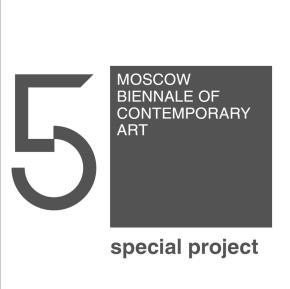
Spaces of Exception
Please note: Flash 7 or higher is required to properly view this website.
Click here to download and install the latest version of Flash

Spaces of Exception
Please note: Flash 7 or higher is required to properly view this website.
Click here to download and install the latest version of Flash

![]() smba-newsletter-134.pdf (518 Kb)
smba-newsletter-134.pdf (518 Kb)
ARTPLAY, Moscow
11 - 26 September 2013
Open every day from 11 a.m. to 8 p.m.
Free admittance
Participating artists:
Yuri Albert, Ivan Brazkin, Chto Delat, Yevgeniy Fiks, Nikita Kadan/Alexander Burlaka, Gulnara Kasmalieva/Muratbek Djumaliev, Gert Jan Kocken, Irina Korina, Jiri Kovanda, Maryanto, Taus Makhacheva, Renzo Martens, Metahaven, Aernout Mik, Marina Naprushkina, Nikolay Oleynikov, Anna Parkina, Dmitry Prigov, Tima Radya, Willem de Rooij, Haim Sokol, Jonas Staal, Roy Villevoye, Carey Young, Katarina Zdjelar.
Choreographer: Anna Abalikhina
Exhibition architect: Maria Kalinina
Curated by Elena Sorokina & Jelle Bouwhuis
Stedelijk Museum Bureau Amsterdam presents the exhibition Spaces of Exception in Moscow. The title of the exhibition refers to the state of economic emergency progressively becoming a new rule and a new norm today. The growing conflict between rights and markets, peaking with the current crisis, affects democracies or would-be democracies as their merits and values are constantly tested and questioned, or even intentionally ignored. The 25 artists in the exhibition construct their own ‘exceptional’ spaces within the realm of art for political maneuvering and blunt or subtle commentary. Sometimes the artists act as ‘legislators’ inventing their own rules of engagement for specific social, political or economic problems. The exhibition is part of the Dutch-Russian Year program, and a special project for the Moscow Biennial 2013.
‘Spaces of Exception’ brings together both existing and newly conceived works. The oldest piece in the exhibition is the Book of decrees (1977) by the legendary Russian conceptualist Dmitry Prigov (1940-2007). The book consists of only six pages, but each of them proudly enunciates a decree signed by
“D. Prigov, chairman”. Included are the following: the decree of the animal, decree of the air, decree of closeness, decree of unit, decree of black, and ultimately, the decree of decree. Prigov’s decrees evoke an absurd revolutionary hero in times of stagnation, while the artist himself imitates and parodies the role of a legislator.
The exhibition ‘Spaces of Exception’ takes up the antiquated myth of the artist as legislator from today's point of view, when artists assume multiple identities as producer, researcher, worker, romantic entrepreneur, cognitive proletarian, critic of nationalist propaganda, etc. Like Prigov, they stage legal texts or cases, create alternative laws and legal systems, criticizing the current state of affairs. The most striking example in the exhibition is the installation New World Summit by Jonas Staal, which stages alternative parliaments at the service of what are labeled terrorist groups, which are active around the world and often fight state repression.
Others comment on the state of exception as a manifold reality in today’s society. This is explicit in the work of the Russian collective Chto Delat, whose ‘Lehrstücke’ have so far rarely been shown in Moscow. An earlier statement of the group resonates throughout this exhibition: “…A ‘state of emergency’ is in the process of becoming a quotidian reality, a strange new ‘norm’ that affects all areas of life, a grey backdrop for the everyday. New systems of surveillance are implemented; public space is privatized and placed under strict control; censorship dams the flow of information; passport controls and travel restrictions limit freedom of movement; suspicious individuals are searched and detained; elections are falsified, all in the name of the battle for democracy and human rights.” Chto Delat will present two film works, one of which was produced in the Netherlands. Artists like Aernout Mik, Ivan Brazhkin and Renzo Martens reflect on war as a state of emergency, while others comment on specific colonial histories that, although invisible, still resonate today. Finally, the exhibition itself functions as a space of exception. Through her work Obsidian Contract, Carey Young permits the visitor to use the exhibition space differently than legally regulated public spaces.
The exhibition will also serve as a stage for the choreographer Anna Abalikhina. She will appropriate the show and use it as an exceptional space of rehearsal right after its opening. Engaging with the entire exhibition, she will reconsider the Soviet tradition of the parade and its mass ornaments as a carnival-cum-demonstration. The results of this collaboration between the curators and the choreographer will be performed on September 17th.
The exhibition is accompanied by an edition of the SMBA Newsletter (bilingual English/Russian) with an introduction by the curators, Elena Sorokina and Jelle Bouwhuis, as well as information on all of the exhibited works. This Newsletter is available in the exhibition space in Artplay and in SMBA, as well online as PDF.
Elena Sorokina is an independent curator
Jelle Bouwhuis is head curator of Stedelijk Museum Bureau Amsterdam
“Spaces of Exception” is organized by Stedelijk Museum Bureau Amsterdam (SMBA), The Netherlands. It is a Special Project of the Moscow Biennial 2013, held in the framework of The Netherlands/Russian Federation Year 2013.
‘Spaces of Exception’ It has been made possible with support of the Mondrian Fund, The Netherlands.